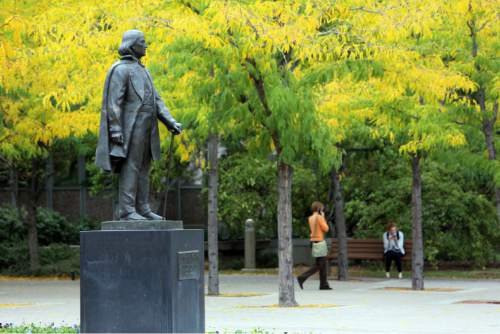This is an archived article that was published on sltrib.com in 2016, and information in the article may be outdated. It is provided only for personal research purposes and may not be reprinted.
A student in his first semester at Brigham Young University-Idaho this fall has yet to encounter a female professor on campus.
When his father recently described his experience to Michael Austin, executive vice president for academic affairs at Indiana's University of Evansville, it jogged Austin's memories of being a BYU English major in the late 1980s.
"The four years that I was an undergraduate student at BYU, I had one female professor, or instructor, the whole time," Austin said. "It was Victorian literature. It was Susan Howe."
Curiosity piqued, Austin turned to the Integrated Postsecondary Education Data System, a database of college and university information administered by the National Center for Education Statistics.
The data corroborated Austin's own experience and that of his friend's son — BYU's three campuses are among the nation's worst for female representation among professors.
Women accounted for 20 percent of instructors with faculty status at BYU-Provo, 15 percent at BYU-Hawaii and 12 percent at BYU-Idaho, the data show.
Those percentages put BYU in the bottom 100 schools for faculty gender equality, Austin said, out of more than 3,200 institutions included in the IPEDS database.
"They're not low for adjunct professors," Austin said of BYU. "And they're certainly not low for administrative assistants, which are overwhelmingly female."
Austin posted his findings on the LDS-themed blog By Common Consent on Friday. He said the data are from 2013, the most recent year for which national numbers are available.
BYU spokeswoman Carri Jenkins said more recent data show a higher percentage of female faculty members.
Including part-time faculty bumps the percentage up to 32.4 percent, she said, and the percentage of full-time faculty members who are women is currently 21.1 percent.
"In every college at BYU we work to recruit female faculty," Jenkins said. "Part of this effort includes encouraging our own female undergraduate students to go on to graduate school and then tracking their progress."
Utah Valley University professor Susan Madsen worked at BYU as an adjunct professor in 2001. She said departments such as education had better female representation, but she was noticeably outnumbered in the Marriott School of Management.
"In the more male-dominated areas it's going to be even more striking," she said.
Madsen, who also directs the Utah Women and Leadership Project, said low participation by women in academia extends beyond BYU.
Fewer Utah women earn degrees than the national average, she said, and a lack of female professors leads female students to self-select out of academic careers.
"If you don't see people of your gender in things, you don't even think you can do it," Madsen said.
Austin said gender misrepresentation could teach male students to not take women seriously in the workplace.
"That is just a devastating message," he said. "That does not prepare men to succeed in the workplace today, where there are women supervisors at almost every level."
In his post for By Common Consent, Austin first compared BYU's gender demographics to schools in the Big 12 athletic conference, which BYU hopes to join. Iowa State University had the smallest percentage of female faculty, at 35 percent, or 15 percentage points higher than BYU-Provo.
Austin wrote that the Big 12 comparison was perhaps unfair, as BYU is owned and operated by The Church of Jesus Christ of Latter-day Saints, which emphasizes traditional gender roles.
But when he compared BYU to other religious institutions, such as Liberty University, Bob Jones University and the University of Notre Dame, the LDS Church-owned campuses remained at the bottom of the list.
Austin said BYU's numbers are more in line with engineering schools, military academies and Bible colleges representing religions that don't allow female pastors. He emphasized that he was not a researcher performing a study, but was simply curious about BYU's self-reported demographic statistics.
Austin suggested that BYU could more often hire non-Mormon faculty, pointing to his own position as second-in-command at a Methodist school as evidence that BYU could remain a Mormon university with faculty of other faiths.
"The more filters you put on a job search," he said, "the less chance you have of finding the best candidates."
Jenkins said BYU is making efforts to recruit and retain female faculty. "We are encouraged that the pool of women Ph.D. candidates who have a desire to teach at BYU is growing," she said.
Twitter: @bjaminwood —
Female faculty percentages at Utah universities
Western Governors University • 76.4 percent
Weber State University • 45.84 percent
Dixie State University • 42.37 percent
University of Utah • 38.48 percent
Southern Utah University • 36.44 percent
Utah State University • 35.23 percent
Utah Valley University • 33.85 percent
Brigham Young University • 20.47 percent
Source: National Center for Education Statistics, data compiled by Michael Austin



